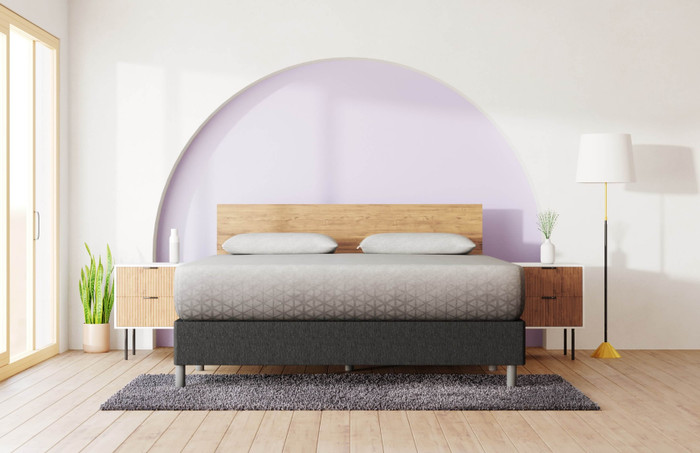How to Childproof a Bedroom?

November 4th, 2025 . 11 mins read
Key Takeaways
- Eliminate common hazards: Anchor heavy furniture, cover electrical outlets, and secure cords to prevent tipping, shocks, or entanglement risks as children explore their space.
- Create a safe and healthy sleep zone: Use firm, non-toxic, and breathable mattresses; avoid soft bedding for infants; and maintain good air quality and temperature control for restful, safe sleep.
- Adapt safety as your child grows: Regularly reassess the room layout, furniture, and play areas to match developmental stages—updating locks, guards, and safety measures to ensure ongoing protection.
Creating a safe environment for your child is one of the most important responsibilities as a parent.
While the entire home requires attention, the bedroom deserves special care since it’s where your child spends a significant amount of time sleeping, playing, and exploring.
Young children are naturally curious, and without the right precautions, a bedroom can quickly become a source of accidents.
Childproofing a bedroom is not just about installing locks and covers—it’s about creating a secure space that encourages independence while minimizing risks.
| Best Hybrid Mattress for Safe, Sturdy Comfort: | Zoma Hybrid |
| Best Budget Mattress for Everyday Safety: | Zoma Start |
| Best Luxury Mattress for Family-Friendly Durability: | Zoma Boost |
How To Childproof a Bedroom?
1. Secure Heavy Furniture and Fixtures
One of the most overlooked yet dangerous hazards in a child’s bedroom is unstable furniture. Dressers, wardrobes, and bookshelves may look solid, but they can easily topple if a child decides to climb or tug on them.
To reduce the risk of accidents, parents should anchor heavy furniture to the wall using anti-tip straps or sturdy brackets.
It is equally important to avoid placing toys, remotes, or favorite items on top of tall furniture, since this often tempts children to climb.
When purchasing new pieces, opt for low-profile designs with wide bases, as these are far less likely to tip over. Taking these steps ensures that the bedroom remains a safe space for play and rest, without hidden risks lurking in plain sight.
2. Cover Electrical Outlets and Manage Cords
Children are naturally curious, and electrical outlets are often right at their eye level, making them an irresistible danger. Exposed sockets can lead to severe shocks, so covering them with sliding covers or outlet caps is essential.
At the same time, dangling cords from lamps, baby monitors, or chargers can become tripping hazards or even pose a risk of strangulation. To prevent this, parents should use cord shorteners, clips, or concealment channels to keep wires neatly tucked away.
Additionally, outlets should never be overloaded with multiple plugs, as this increases both fire risk and a child’s curiosity to touch.
By properly managing outlets and cords, you create a safer, clutter-free environment that promotes both protection and peace of mind.
3. Ensure Window and Curtain Safety
Windows may appear harmless, but they present serious risks for young children. Without proper safeguards, children may climb near windows and risk dangerous falls.
Installing window locks or childproof guards is a simple yet effective way to limit how far windows can open. Parents should also avoid blinds with long cords, as these can cause accidental strangulation.
Cordless blinds or wind-up cord devices are safer alternatives that reduce risks without compromising style. It’s also vital to remember that window screens are not designed to hold weight; they are meant to keep insects out, not children in.
By reinforcing windows and choosing safe curtain options, parents can provide children with natural light and fresh air without compromising safety.
4. Choose Safe Bedding and Cribs
For infants and toddlers, the sleeping environment is one of the most crucial areas to childproof. A firm, snug-fitting mattress inside the crib prevents gaps where babies could become trapped, lowering the risk of suffocation.
Soft bedding such as pillows, heavy blankets, or stuffed animals should never be placed in an infant’s crib, as these items can obstruct breathing. As children transition into toddler beds, low-profile frames with secure guardrails are ideal for minimizing falls during the night.
These adjustments ensure not only comfort but also the highest level of safety while your child rests. Creating a secure sleep setup helps parents feel confident that their little ones are safe during the most vulnerable hours of the day.
5. Lock Away Dangerous Items
Bedrooms may seem harmless compared to kitchens or bathrooms, but they can still contain dangerous objects. Items such as medications, cosmetics, perfumes, or creams stored in drawers can be hazardous if accessed by children.
Small objects like coins, jewelry, or batteries also present a choking hazard and should be kept out of reach. In some cases, parents may also store cleaning supplies in or near the bedroom, but these should always be relocated to a locked cabinet.
By locking away or removing harmful objects, parents can turn the bedroom into a secure retreat where children can explore and play freely without encountering hidden dangers.
6. Use Baby Gates and Door Locks Wisely
Childproofing a bedroom is not only about securing the interior but also controlling access to other areas. Installing childproof covers on door handles prevents unsupervised exits, keeping children from wandering into potentially unsafe parts of the home.
If the bedroom is located near stairs or connected to risky areas, a sturdy baby gate adds another protective layer. Parents may also choose to install a baby monitor, offering additional reassurance by allowing them to keep an eye on their child even from another room.
These steps help maintain both security and independence, ensuring the bedroom remains a safe boundary within the home.
7. Create a Safe Play Area
Since children often use their bedrooms for both sleeping and playing, it is vital to design a safe play environment. Toys should always be age-appropriate and meet established safety standards, reducing risks of choking or injury.
To cushion falls during playtime, soft rugs or padded mats can be added to the floor. Sharp furniture corners should be covered with protective guards, especially on toy chests or low tables that children often run into.
By balancing fun with safety, parents create a nurturing space where children can play, explore, and learn without unnecessary risks.
8. Be Mindful of Décor and Accessories
Decorating a child’s room can be exciting, but every design choice should consider safety first. Heavy décor items such as framed pictures, shelves, or mirrors must be securely fastened to walls so they cannot fall.
Parents should avoid hanging anything heavy directly above a child’s bed, as this poses a serious hazard if it becomes loose. Another key factor is indoor air quality, which can be affected by paints and finishes.
Choosing non-toxic, low-VOC paints ensures a healthier environment for your child to grow in. With careful planning, it’s possible to design a room that feels both inviting and safe.
9. Maintain Good Air Quality and Temperature
The environment of a child’s bedroom goes beyond physical safety—it also includes air quality and temperature control. Installing smoke and carbon monoxide detectors near bedrooms provides a critical layer of protection in emergencies, and these should be tested regularly.
Maintaining a moderate room temperature is equally important, as overheating is a known risk factor for sleep-related accidents. Parents may also use humidifiers or air purifiers to support clean, comfortable air, but these devices should be placed out of reach with cords secured.
By monitoring both temperature and air quality, you create an environment that supports not only safety but also healthier, more restful sleep.
10. Regularly Reassess the Room
Childproofing is not a one-time effort but an ongoing process that evolves as your child grows. What is safe for a baby may become risky for a toddler who can now climb, open drawers, or reach new heights.
Parents should periodically reassess the bedroom by getting down to the child’s level and looking for potential hazards from their perspective. Safety measures should also be updated—for example, transitioning from outlet covers to furniture locks as needs change.
The key is to stay proactive and anticipate your child’s next stage of development instead of reacting only after an incident occurs. By doing so, the bedroom remains a safe haven through every stage of growth.
Why Childproofing a Bedroom Matters?
Children are naturally curious by nature, and this curiosity is a vital part of their learning and development. However, the same eagerness to climb, touch, and explore can also put them in dangerous situations—especially within their own bedrooms.
What may look like a harmless piece of furniture, a colorful toy, or a dangling cord to adults can quickly become a source of risk for little ones. By focusing on childproofing, parents can transform bedrooms into safe, nurturing spaces where children are free to grow, play, and rest without constant worry.
The importance of childproofing lies in preventing common accidents before they happen. Simple but overlooked hazards, such as unstable furniture, loose cords, or small objects left within reach, can result in injuries that are otherwise avoidable.
Falls from beds or climbing accidents with shelves are among the most frequent risks, while choking hazards from coins, batteries, or tiny toys pose silent but serious threats.
Even bedding, if not chosen carefully, can increase the danger of suffocation for infants and toddlers. Adding to these concerns, sharp edges on furniture or unsecured wall hangings can lead to bumps, bruises, or more severe injuries during playtime.
By taking proactive measures, parents can significantly reduce these risks and create a balanced environment that supports both safety and comfort. A childproofed bedroom not only protects children physically but also provides peace of mind to caregivers.
Instead of constantly worrying about accidents, parents can feel reassured knowing their child’s environment has been thoughtfully secured.
Ultimately, the goal of childproofing is not to restrict exploration, but to create a space where curiosity can flourish in a safe, controlled manner—helping children thrive while giving families the confidence that their loved ones are protected.
Select the Best Mattress for Your Child
When setting up a safe and nurturing bedroom for children, the mattress is one of the most important elements to consider. It does more than provide a surface to sleep on—it supports healthy growth, improves sleep quality, and ensures long-term well-being.
Best Mattress Type for Infants
For newborns and infants, safety must always come before comfort. A firm crib mattress is recommended to reduce the risk of suffocation and Sudden Infant Death Syndrome (SIDS). Soft mattresses may seem cozy, but they can trap a baby’s face, making it harder to breathe.
A firm mattress ensures infants have a stable, flat surface that supports safe sleep practices. Parents should also ensure the mattress fits snugly into the crib without leaving gaps where a baby could get stuck.
Ideal Mattress for Toddlers and Older Kids
As children grow into toddlers and school-aged kids, their needs change. At this stage, a medium-firm mattress is usually the best option. It provides enough cushioning for comfort while still supporting spinal alignment during years of rapid growth.
A mattress that is too soft may cause sinking, leading to misalignment of the spine, while one that is too hard may feel uncomfortable and disrupt sleep. A medium-firm design strikes the perfect balance, ensuring that kids wake up refreshed and ready for the day.
Why Non-Toxic Mattresses Are Safer for Children?
Children are more sensitive to their environment, which means they are at greater risk from exposure to toxic chemicals often found in conventional mattresses. Materials like flame retardants, phthalates, and VOCs can release harmful gases that affect indoor air quality.
Over time, these toxins may contribute to respiratory issues, allergies, or skin irritation. Choosing a non-toxic or organic mattress helps minimize these risks. Look for certifications like CertiPUR-US®, Greenguard Gold, or GOTS-certified organic cotton, which guarantee that the mattress is free from harmful chemicals and safe for daily use.
The Importance of Breathability in a Child’s Mattress
Breathability is another key factor in ensuring a safe sleep environment. A breathable mattress allows fresh air to circulate, which prevents overheating and helps regulate body temperature. This is particularly important for babies, as overheating is considered a risk factor for unsafe sleep.
Breathable designs also reduce the buildup of carbon dioxide, making them a safer option. For older children, breathability ensures comfort throughout the night, especially in warmer climates or during summer months.
Washable and Waterproof Mattress Covers for Hygiene
No matter how careful parents are, spills and accidents are part of childhood. That’s why having a washable or waterproof cover is essential for maintaining a clean and hygienic mattress.
A removable, machine-washable cover makes cleanup simple and prevents bacteria, mold, or allergens from developing inside the mattress. Waterproof protection also extends the mattress’s lifespan by preventing liquid damage.
This feature not only adds convenience for parents but also ensures that children sleep in a healthy and safe environment every night.
Age-Based Childproofing Strategies
1. For Infants
For infants, the primary concern is the sleep environment. Babies spend much of their time resting, so ensuring a firm mattress, snug crib, and minimal bedding is critical to reducing suffocation risks.
Parents should also pay attention to air quality, room temperature, and noise levels, as these factors directly affect infant health and sleep safety.
Since infants are not yet mobile, hazards like sharp corners or cords are less of a concern at this stage, but preparing early can save effort later as they begin to crawl.
2. For Toddlers
Once children reach the toddler stage, mobility and curiosity increase dramatically. Toddlers love climbing, opening drawers, and exploring anything within reach, which makes furniture anchoring, outlet covers, and toy safety more important than ever.
Soft flooring and corner protectors help reduce injury from inevitable falls, while baby gates and door locks can restrict access to unsafe areas.
Parents should also begin teaching simple safety habits, such as why cords and small objects must be avoided, since toddlers are old enough to start absorbing rules through repetition.
3. For Preschoolers
By the time children are in the preschool years, their play becomes more independent, and their ability to access higher places makes new hazards possible.
At this age, parents should reassess furniture placement, window locks, and wall décor to prevent falls or accidents.
Toys should continue to be age-appropriate and free from choking hazards, but the focus can also shift toward creating safe, organized play areas that encourage creativity.
Teaching children about safe boundaries, like not leaning on windows or climbing shelves, becomes essential at this stage.
4. For Older Children
For older children, while the risk of choking or suffocation may be lower, other concerns emerge. Electronics, chargers, and study materials are often introduced in their rooms, making cord management, outlet safety, and fire prevention even more important.
As kids become more independent, involving them in the safety process helps them understand responsibility. Explaining why certain rules exist not only reinforces safety but also encourages lifelong habits of awareness and care.
Common Mistakes and Safer Alternatives
- Furniture anchoring: Many parents assume heavy furniture is stable, but it can tip if climbed on. Secure dressers, wardrobes, and bookshelves with anti-tip straps or wall brackets, and check anchors regularly for tightness.
- Window safety: Relying on screens gives a false sense of security, as they cannot prevent falls. Instead, install childproof window locks or guards to limit how far windows can open.
- Tempting objects on tall furniture: Placing toys, remotes, or favorite items on high shelves encourages climbing. Keep these items at a child’s level to avoid unnecessary risks.
- Unsafe bedding: Adding pillows, stuffed animals, or blankets to an infant’s crib increases suffocation hazards. Stick to a firm mattress with a snug fitted sheet and no extra bedding.
- Outdated precautions: Safety needs change as children grow, but many parents forget to reassess. Conduct regular room inspections and update precautions, such as switching from outlet covers to furniture locks.
- Loose cords: Dangling lamp, blind, or charger cords pose strangulation and tripping risks. Use cord shorteners, clips, or cordless window treatments to keep cords safely out of reach.
- Small choking hazards: Items like batteries, coins, or jewelry are often overlooked. Store these securely in locked drawers or higher cabinets away from curious hands.
- Overloaded outlets: Plugging too many devices into one socket creates both fire hazards and curiosity for children. Use outlet covers and avoid overloading to keep the setup safe.
- Heavy décor above beds: Hanging mirrors, frames, or shelves over sleeping areas can be dangerous if they fall. Keep walls above beds clear or use only lightweight, firmly secured décor.
- Skipping safety checks: Parents often assume that once a room is childproofed, it stays safe. Inspect the bedroom every few months at your child’s eye level to identify new risks as they grow.
FAQs
At what age should I childproof a bedroom?
You should begin childproofing a bedroom before your baby starts crawling, typically around 6 months old. Early preparation helps prevent accidents such as falls, choking hazards, or access to unsafe objects. As your child grows, continue to update safety measures to match their new mobility and curiosity.
What mattress firmness is best for children?
Infants need a very firm crib mattress for safety and healthy development. Toddlers and older children sleep best on a medium-firm mattress that supports spinal alignment and comfort. Look for CertiPUR-US® certified foam or organic materials to ensure a safe and non-toxic sleep environment.
When should a child transition from a crib to a toddler bed?
Most children are ready to move from a crib to a toddler bed between 18 months and 3 years. Signs of readiness include climbing out of the crib or showing interest in bigger beds. For safety, use toddler beds with guardrails and maintain a childproof room during the transition.
Are memory foam mattresses safe for kids?
Memory foam is not safe for infants, as it increases suffocation risks. For toddlers and older children, memory foam can be a good option if it’s medium-firm, breathable, and certified safe. Always avoid overly soft or uncertified foam mattresses that may expose kids to harmful chemicals.
Is a foam or spring mattress better for kids?
Both options can work well. Foam mattresses (if certified safe) provide soft contouring, while spring mattresses offer bounce and durable support. Many parents choose hybrid mattresses for a balance of comfort and structure.
When should I replace my child’s mattress?
Most children’s mattresses should be replaced every 7–10 years, but earlier if there are signs of sagging, lumps, or discomfort. Since children’s bodies are growing rapidly, proper mattress support is crucial for healthy development.
Are organic mattresses worth it for kids?
Yes, organic mattresses made of natural latex, organic cotton, or wool are a healthier choice for kids. They’re free of harmful chemicals, hypoallergenic, and breathable—ideal for families who value safe sleep and eco-friendly living.
Final Thoughts
Childproofing a bedroom is not a one-time task—it’s an ongoing process that evolves with your child’s growth. The goal is to create a safe space where your little one can sleep peacefully, explore freely, and play without unnecessary risks.
From securing furniture and outlets to choosing safe bedding and décor, each step makes the environment safer and gives you peace of mind as a parent. By staying proactive and reassessing safety measures regularly, you’ll ensure your child’s bedroom remains a secure and comforting sanctuary.
This article is for informational purposes and should not replace advice from your doctor or other medical professional.


